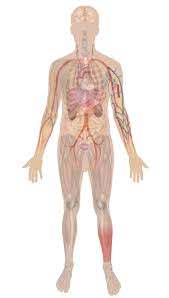
The human body is made from the same components as every other living thing. It is the way that they are put together that makes our bodies uniquely human. The basic materials are simple chemicals such as water, carbon, and oxygen, but they join to create more complex compounds. Trillions of microscopic cells become the building blocks of life, grouping together to form skin, bone, blood, and organs, until the body becomes complete.
Body composition may be analyzed in various ways. This can be done in terms of the chemical elements present, or by molecular type e.g., water, protein, fats (or lipids), hydroxylapatite (in bones), carbohydrates (such as glycogen and glucose) and DNA. In terms of tissue type, the body may be analyzed into water, fat, connective tissue, muscle, bone, etc. In terms of cell type, the body contains hundreds of different types of cells, but notably, the largest number of cells contained in a human body (though not the largest mass of cells) are not human cells, but bacteria residing in the normal human gastrointestinal tract.
Picture Credit : Google

